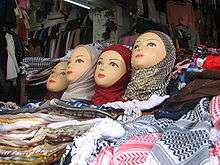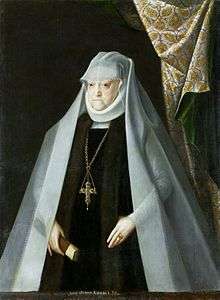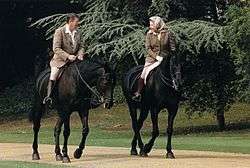Headscarf


Headscarves or head scarves are scarves covering most or all of the top of a woman's hair and her head, leaving the face uncovered. Apart from the keffiyeh of the Middle East, headscarves worn by men are much less common and usually for practical purposes. Headscarves may be worn for a variety of purposes, such as protection of the head or hair from rain, wind, dirt, cold, warmth, for sanitation, for fashion, recognition or social distinction; with religious significance, to hide baldness, out of modesty, or other forms of social convention.[1][2]
Headscarves and religion

Headscarves may specifically have a religious significance or function, or be expected as a matter of social custom, the two very often being confused.
Headscarves and veils are commonly used by observant Muslim women and girls, and required by law for women and girls in certain Muslim countries (Saudi Arabia for example). The Muslim religious dress varies, and various cultures include burqa, chador, niqab, dupatta, or others. The Arabic word hijab, which refers to modest behaviour or dress in general, is often used to describe the headscarf worn by Muslim women and girls.[3]
Until at least the Renaissance, some form of cover for the hair was regarded as appropriate for married women in most European cultures, to agree with contemporary notions of modesty and as an indication of married status; the "matron's cap" is a general term for these. For un-married women it was considered appropriate to display their hair to attract suitors. The social elite, especially royalty, generally did not feel bound by these customs, unless they were widows. To some extent, the covering of the head depended on where the woman was; indoors and at home it was less worn, but it was usual outside and on formal occasions, especially in church.[4] After the Renaisssance, the custom slowly declined,[5] but the Roman Catholic Church required all women to wear at least a veil over their hair in church until the 1960s; these are often called mantillas, from the Spanish. Women meeting the Pope in formal audiences are still expected to wear them. Martin Luther and John Calvin also expected women to cover their heads in church.
In many rural areas, older women, especially widows, still observe the custom, especially in eastern and southern Europe. At times the styles of covering using simple cloth became very elaborate, with complicated layers and folding, held in place with hair pins. Among the many terms for head-coverings made of flexible cloth are wimple, hennin, kerchief, gable hood, as well as light hats, mob caps and bonnets.
.jpeg)
In countries with large Eastern Orthodox Christianity population such as Romania [6] or Russia[7] headscarves and veils are used by Christian women in the Eastern Orthodox Church, Oriental Orthodox Church, Assyrian Church of the East, and Roman Catholic Church.[8][9][10] A few years back, all women in Russia who attended Divine Liturgy wore head-coverings. A women having her head covered means that she honors the Lord. Head-coverings also symbolizes that a woman is married and that her husband is the head of the family. Little girls also have their heads covered when they go to Mass at church, not because they are married, but in order to honor the Lord. Today, young Russian Orthodox women and little girls still cover their heads when going to church, but with a different type of headscarf: Mantilla, which is a silk or lace scarf. Nowadays only woman of older age (grandmothers) wear full head coverings.
Some English speakers use the word "babushka" (the word for 'grandma' in Russian: ![]() бaбушка ) to indicate a headscarf tied below the chin, as still commonly worn in rural parts of Europe. In many parts of Europe, headscarves are used mainly by elderly women and this led to the use of the term "babushka", a Slavic word meaning 'grandmother'. Some types of head coverings that Russian women wear are: circlet, veil, and wimple.
бaбушка ) to indicate a headscarf tied below the chin, as still commonly worn in rural parts of Europe. In many parts of Europe, headscarves are used mainly by elderly women and this led to the use of the term "babushka", a Slavic word meaning 'grandmother'. Some types of head coverings that Russian women wear are: circlet, veil, and wimple.
In many branches of Orthodox Judaism, married women are required to cover their hair with scarves, known as tichels or snoods, in compliance with the code of modesty known as tzniut. These hair coverings come in different shapes and sizes. Tichel is a veil where it covers all the hair and towards the back of the head the left over veil is made into a bun. Snoods belong to almost the same style, and are worn more like a hat. An alternative is to cover the natural hair by wearing a wig or a beret.
Image gallery
 School girls in Herat, Afghanistan.
School girls in Herat, Afghanistan. Oil on canvas painting by Vittore Ghislandi, called Fra Galgario.
Oil on canvas painting by Vittore Ghislandi, called Fra Galgario.
_-_TIMEA.jpg) A woman selling flowers. Egypt, 1906.
A woman selling flowers. Egypt, 1906.- Girls dressed up for a parade wear matching yellow headscarves. 2009, New Orleans, Louisiana.
 Woman with a headscarf in Gambia
Woman with a headscarf in Gambia Egypt, 1935.
Egypt, 1935. A headscarf for chefs; Los Angeles, 2007.
A headscarf for chefs; Los Angeles, 2007. Three Turkish women wearing headscarves, 2003.
Three Turkish women wearing headscarves, 2003. Laughing woman in Kuala Lumpur wearing a blue headscarf, 2008.
Laughing woman in Kuala Lumpur wearing a blue headscarf, 2008. A young Malaysian woman wearing a headscarf, 2010.
A young Malaysian woman wearing a headscarf, 2010. Women typical dress and headscarf; Nazaré, Portugal, 2006.
Women typical dress and headscarf; Nazaré, Portugal, 2006. Salvadoran women wear distinctive regional veils for national celebrations.
Salvadoran women wear distinctive regional veils for national celebrations. A young Somali woman in a traditional headscarf.
A young Somali woman in a traditional headscarf.
See also
| Wikimedia Commons has media related to Headscarves. |
- Christian headcovering
- Headscarf controversy in Turkey
- Islamic dress in Europe
- Shalwar Kameez
- Veil
- Bandana
References
- ↑ rosaliegilbert.com - Veils, Wimples and Gorgets
- ↑ christianity.stackexchange.com - What happened to the practice of women covering their heads?
- ↑ al-islam.org - Why Hijab?
- ↑ Françoise Piponnier and Perrine Mane; Dress in the Middle Ages; pp. 40, 78-81, 95, 121, Yale UP, 1997; ISBN 0300069065
- ↑ Payne, Blanche; Winakor, Geitel; Farrell-Beck Jane: The History of Costume, from Ancient Mesopotamia to the Twentieth Century, 2nd Edn, pp. 260, 299, 319-324, 356, 386, HarperCollins, 1992. ISBN 0060471417
- ↑ https://theorthodoxlife.wordpress.com/2014/02/04/womens-headcoverings/
- ↑ head covering history -
- ↑ orthodoxinfo.com - On Account of the Angels: Why I Cover My Head
- ↑ academia.edu - Head Covering Among Catholic Laity, a pdf-download page
- ↑ altcatholicah.com - Veiling in Church: Mantilla Manifesto
